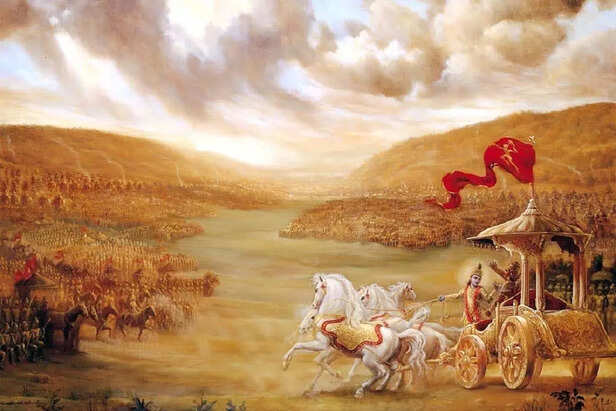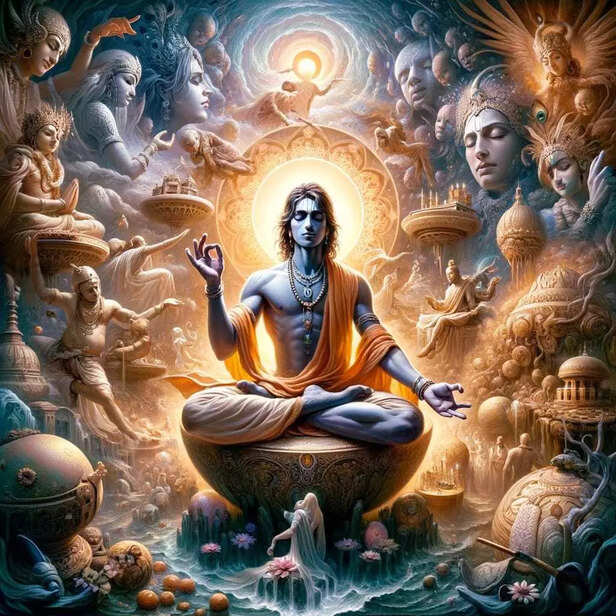From Kurukshetra to Your Soul: Can the Bhagavad Gita Decode Your Inner Conflicts?
Sujeet kumar | Apr 16, 2025, 01:03 IST
Krishna And Arjuna in Kurukshetra
Explore the enduring relevance of the Bhagavad Gita, bridging the ancient battlefield of Kurukshetra with the internal conflicts of modern life. This article examines the core teachings of the Gita's dialogue between Arjuna and Krishna, questioning its capacity to decipher our personal struggles. Uncover insights into duty, detachment, the nature of the self, and the path to inner peace. Discover if this timeless scripture offers practical guidance for navigating anxiety, decision-making, and the search for meaning in our own "inner war," revealing the Gita's potential as a guide for contemporary souls seeking resolution
Journey from the epic battlefield of Kurukshetra to the intimate landscape of your inner struggles. This article delves into the timeless wisdom of the Bhagavad Gita, exploring its profound dialogue between Arjuna and Krishna. Can this ancient scripture, born amidst war, offer a practical guide to navigating the conflicts within ourselves? Uncover the Gita's insights on duty, detachment, and the nature of the self, and discover if its age-old teachings hold the key to understanding and resolving the battles fought not on a physical field, but within the depths of your own soul in the complexities of modern life.
A key
The meaning of this Sloka is "But if you abandon this Dharma and do not follow your nature, then your actions will be corrupted." This verse emphasizes the importance of aligning one's actions with one's true nature (Dharma) to overcome inner turmoil.

The Bhagavad Gita offers profound insights that can be applied to understanding and potentially decoding
The setting of the Gita – a battlefield – is often interpreted as a metaphor for the internal struggles and ethical dilemmas individuals face in their lives. Arjuna's emotional turmoil and reluctance to fight his own kin mirror the anxieties and conflicts we experience within ourselves.
The Gita emphasizes the distinction between the eternal self (Atman) and the temporary physical body and ego. Recognizing your true, unchanging nature can provide a sense of stability amidst inner turmoil and help you detach from fleeting emotions and desires that often fuel conflict.
The Gita stresses the importance of fulfilling one's duty according to their nature and circumstances, without attachment to the results. Understanding and aligning with your "dharma" can provide a sense of purpose and direction, potentially resolving conflicts arising from uncertainty or a lack of meaning.The
The Gita explains how our actions, both physical and mental, create consequences that shape our future. Understanding this can help you become more mindful of your thoughts and actions, potentially mitigating future inner conflicts arising from negative patterns.
A key teaching of the Gita is to perform your duties without being attached to the outcomes. This principle can help reduce anxiety and inner conflict caused by worrying about results that are beyond your control. By focusing on the effort rather than the fruit of the action, you can find greater peace.
The Gita advocates maintaining a balanced state of mind in the face of both pleasure and pain, success and failure. Cultivating equanimity can help you navigate the ups and downs of life without succumbing to emotional extremes that often lead to inner conflict.
The Gita provides a detailed analysis of desires and emotions, highlighting their role in both spiritual development and human behavior. Understanding how desires can lead to attachment and suffering is crucial in managing inner conflict.
The Gita outlines different paths of Yoga – Karma Yoga (the yoga of action), Bhakti Yoga (the yoga of devotion), and Jnana Yoga (the yoga of knowledge) – as ways to achieve self-realization and inner peace. Exploring these paths can offer practical tools for resolving inner conflicts based on your individual inclinations.
The Gita also touches upon the importance of surrendering to a higher power or universal truth. Developing faith can reduce the burden of feeling solely responsible for outcomes and bring a sense of peace amidst inner struggle.

Many individuals, including psychologists and philosophers, have found profound wisdom in the Bhagavad Gita that offers guidance for navigating the complexities of the human psyche and resolving inner conflicts. Its teachings encourage self-awareness, ethical action, emotional regulation, and a broader perspective on life's challenges, all of which are valuable in addressing internal battles.
Explore the latest trends and tips in Health & Fitness, Travel, Life Hacks, Fashion & Beauty, and Relationships at Times Life.
A key sloka for fighting inner conflict in the Bhagavad Gita is Chapter 2, Verse 68:
"अथ चेत्त्वमिमं धर्मम् इत्थं स्यात् स्युस्ते कर्मभिः।"

Battle Field Kurukshetra
The Bhagavad Gita offers profound insights that can be applied to understanding and potentially decoding inner conflicts :
Here's how the Bhagavad Gita can be relevant to your inner conflicts:
The Battlefield as a Metaphor:
Understanding the Self (Atman):
The Concept of Dharma (Duty):
The Law of Karma (Action and Consequence):
Detachment (Non-attachment):
Equanimity (Balance):
The Nature of Desires and Emotions:
The Path of Yoga:
Surrender and Faith:

Inner Peace
Many individuals, including psychologists and philosophers, have found profound wisdom in the Bhagavad Gita that offers guidance for navigating the complexities of the human psyche and resolving inner conflicts. Its teachings encourage self-awareness, ethical action, emotional regulation, and a broader perspective on life's challenges, all of which are valuable in addressing internal battles.
Explore the latest trends and tips in Health & Fitness, Travel, Life Hacks, Fashion & Beauty, and Relationships at Times Life.
